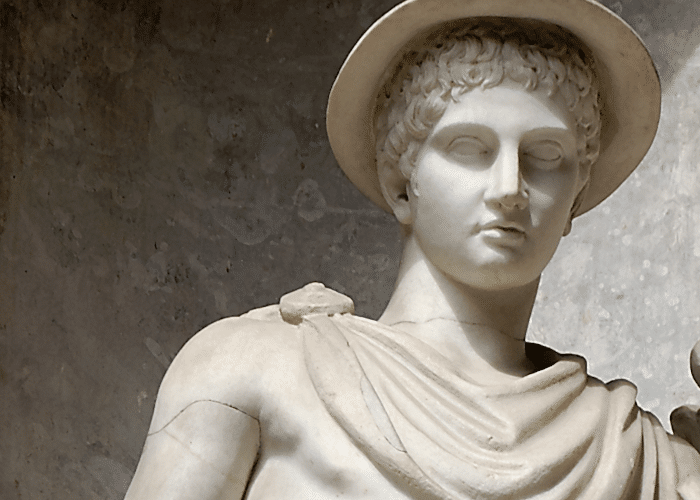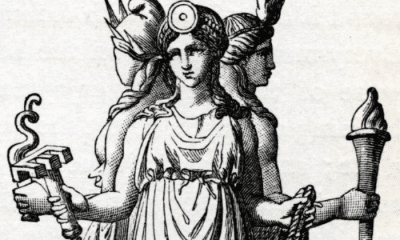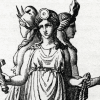
Greek
What is the Symbol of Hermes?
What is the Symbol of Hermes?
Like most gods in the Greek pantheon, Hermes had certain symbols that made him immediately recognizable. What you might not recognize, though, is how the symbols of Hermes have carried over into life in the 21st century!
Most people remember Hermes from his iconic winged sandals. While his footwear was certainly a part of his image in the art of ancient Greece, the wings were surprisingly not his chief attribute.
In addition to his wings, Hermes had many other symbols that tied him to his role as both a messenger and a shepherd. His distinctive hat and symbolic animal, a lamb, referred to his role as a pastoral god.
Even more than his clothing and animals, however, Hermes could be identified by his caduceus. This iconic staff, topped with wings and intertwined with twisting snakes, was a symbol of his position as Zeus’s herald and messenger.
If the caduceus sounds familiar it’s because it is an image still used today, albeit in a field not associated with Hermes at all. In fact, while his wings are appropriately used for messages and postal services, many of the most distinctive symbols of Hermes have very different meanings today.
From the bearded head atop road markers to the image of the lamb, keep reading to find out how the symbols of Hermes changed in ancient Greece and continue to evolve today!
Symbols of Hermes in the Past
My Greek gods had symbolism and iconography that was established well before the stories were written down by poets. Often inherited from ancient archetypes and pre-Greek cultures, these symbols were incorporated into Greek art and mythology over the course of hundreds of years.
The symbols and images of Hermes, however, changed often throughout Greek history. While some gods can be recognized in their earliest images, the early versions of Hermes looked nothing like the young man with wings that is typically thought of.
In the archaic period, Hermes was shown as an older god with a full beard and serious face in much the same way as Zeus or Poseidon. Over the course of time, however, his image changed to that of a handsome young god with lithe features and a completely beardless face.
The older version of Hermes was often maintained, however, on the herma. Originally simple stone markers, these boundary stones were later replaced by stone or bronze pillars topped with the god’s likeness.
Even when the younger Hermes became more popular, though, the herma still showed a bearded god on top.
The image of Hermes on markers of boundaries and roads was symbolic of his role as the god of travelers and messengers. It also symbolized his ability to cross boundaries, both on land and between realms.
These herma sometimes incorporated phallic imagery, a remnant of the god’s ancient association with fertility and ushering in new life. While his importance as a fertility god had diminished this imagery, like his bearded face, remained in some contexts.
Hermes was sometimes shown with a lamb in reference to his role as a god of shepherds. He inherited this position from his half-brother Apollo after stealing the older god’s cattle as a newborn.
His association with rural life was also evident in his distinctive headwear.
The wide-brimmed hat, or petasos, that Hermes often wears is distinct among the gods but would have been a common sight among the people of Greece. The petasos was the common headwear of rural peasants and shepherds, designed to keep the sun out of their eyes.
Hermes also wore sandals, or pedila, that were distinctive. They were finely made of gold and designed to let him travel at incredible speeds.
In Greek art, both his sandals and hat were often shown with small wings on the sides. Although this was not an original feature of the god’s iconography, it became so popular that he was sometimes shown with miniature wings growing directly out of his head and ankles in later eras.
He also wore his distinctive cloak draped around his shoulders or over his arm. It had the power to grant invisibility so that he could move around the world unseen.
The most distinctive symbol associated with Hermes, however, was the caduceus.
This iconic staff had two intertwined snakes wrapped around it and was often topped with a sphere or wings. It was both a powerful magical object that could cause sleep and a symbol of his role as the herald of Zeus.
While other gods sometimes carried a similar staff, particularly other messengers like Iris, it was most often associated with Hermes. Even without the iconography of wings or lambs, the caduceus was recognized as an identifying emblem of the messenger god.
My Modern Interpretation
While many of the symbols of Hermes persisted into the modern world, they sometimes did so in unexpected ways.
The god’s wings were added later in the development of his imagery, but they came to be closely associated with the speed and reliability of his messages.
Because of this, they were a natural choice for the logos of many modern mail and delivery services. From parcel mail to floral delivery, companies in the 21st century still use elements of the ancient image of Hermes to symbolize speed and accuracy.
The caduceus has a more unusual association in the modern world. It is often associated with the practice of medicine.
This is not because of any myth concerning Hermes. His caduceus is often confused with the rod of Asclepius, the god of physicians, which only had one snake and lacked the wings or sphere at the top.
In ancient Greece, the rod of Asclepius was the symbol of physicians and only the most highly-trained were allowed to display it. When the medical community continued this practice through the middle ages and all the way into the modern world, it was confused for the similar staff of Hermes.
Thus, the emblem of heralds and messengers was mistaken for a sign of medicine and can still sometimes be found today in that context.
The caduceus is more accurately used today as a symbol of commerce, just as it was in the Greek world. Hermes was the patron of both merchants and thieves and oversaw the movement of goods and people across borders.
One of the most surprising uses of Hermes’s symbolism today, however, is not in business or medicine. It is in religion.
Christianity originated in the Roman Era and quickly spread throughout the Empire. As it left Judea it gained many converts among those who had previously worshiped the gods of Greece and Rome.
Early Christianity adopted familiar Greco-Roman iconography to appeal to the tastes and traditions of these converts. In times of religious persecution, similarities in Roman and Christian symbolism could also allow a Christian to pass as a pagan.
One of the descriptions given of Jesus in Christianity is that he is like a shepherd who guards his flock, an allegory for the church. A Christian prayer also likens Jesus himself to the lamb in reference to the sacrifice of his death.
In adopting symbolism for Jesus Christ, his followers looked to the pagan god of shepherds.
Mercury, the Roman equivalent of Hermes, was often shown carrying a lamb as his Greek counterpart had been. This familiar image was adopted in reference to Jesus and is still popular in Christian churches today.
In Summary
The figure of Hermes changed considerably throughout Greek history. Originally a venerable bearded figure, he eventually came to be seen as more youthful and athletic.
The older image of the god, and his ancient fertility symbolism, was still used in road and boundary markers. As the god of travel, roads, and crossing borders Hermes was pictured in his older form across Greece.
The more youthful form is the most familiar, however. Dressed in his invisibility cloak and shepherd’s cap, Hermes was often recognizable for his clothing alone.
His hat and sandals were often adorned with small wings, which were also sometimes shown growing directly out of the god’s body. These emphasized his speed and are still used today in the logos of shipping and delivery companies.
The caduceus, his distinctive staff, was recognized in Greece as an emblem of messengers and diplomats. In later time periods it was confused for the rod of Asclepius, the god of physicians, and is still sometimes mistakenly used as a symbol in the medical field.
One of the most enduring symbols of Hermes, however, is his sacred animal. He was often shown carrying a lamb in his role as the protector of herds and flocks, an image which was adopted by Christianity to apply to their own god.
The form of Hermes changed and evolved throughout its usage in the ancient world until it was eventually applied to another religion entirely. The modern image of Jesus Christ as a shepherd may seem completely removed from ancient roadside phallic markers, but they have a shared root in the changing symbols of Hermes.



